Home » Jazz Articles » Multiple Reviews » The Rudy Van Gelder Blue Note Editions
The Rudy Van Gelder Blue Note Editions
The Rudy Van Gelder Edition series kicked off a few months ago here in the States (Rudy had done the remastering job on all these new reissues originally for Japan in 1998) with 12 titles that were well chosen as some of the best Blue Note has to offer from a catalog that is quite large and diverse. Organist Larry Young's Unity is up first and it surely wins an award for one of the best Blue Note albums ever made, along with being simply the most perfect organ record to ever appear! If you don't own this one, then what are you waiting for? Grab it now! For those of you in the know, I suggest this purchase as well. Why? Because the sound is really clearly superior than any version I had heard of this material ever before, including the mastering done on Mosaic's Young boxed set. There's a richness and depth of soundstage that I simply have not experienced before and none of the harshness sometimes associated with compact discs is present. Musically, mere words are inadequate in describing the energy generated by Young, Woody Shaw, Joe Henderson, and Elvin Jones. You simply must hear it for yourself!
 Shortly after leaving John Coltrane's quartet and terminating his own Impulse contract, pianist McCoy Tyner would sign with Blue Note for a series of what would become some of the finest recorded efforts of his career. Surely his previous sideman appearances for the label with the likes of Hank Mobley, Wayne Shorter, and Lee Morgan, to name a few, had endeared him to producer Alfred Lion. His Blue Note debut, The Real McCoy, would prove to be an auspicious start. Just one look at the line-up really tells the story-Tyner, Joe Henderson, Ron Carter, and Elvin Jones. And if that wasn't enough, such Tyner originals as "Passion Dance," "Blues on the Corner," and "Search for Peace" make this another undisputed classic in every sense of the word. The previous CD version had a glaring edge to the saxophone that is fortuitously missing from this new incarnation, making it a must-own.
Shortly after leaving John Coltrane's quartet and terminating his own Impulse contract, pianist McCoy Tyner would sign with Blue Note for a series of what would become some of the finest recorded efforts of his career. Surely his previous sideman appearances for the label with the likes of Hank Mobley, Wayne Shorter, and Lee Morgan, to name a few, had endeared him to producer Alfred Lion. His Blue Note debut, The Real McCoy, would prove to be an auspicious start. Just one look at the line-up really tells the story-Tyner, Joe Henderson, Ron Carter, and Elvin Jones. And if that wasn't enough, such Tyner originals as "Passion Dance," "Blues on the Corner," and "Search for Peace" make this another undisputed classic in every sense of the word. The previous CD version had a glaring edge to the saxophone that is fortuitously missing from this new incarnation, making it a must-own. 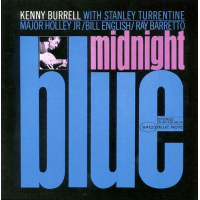 If he had never recorded anything further, guitarist Kenny Burrell would have made a name for himself based on his quintessential Blue Note affair, Midnight Blue. This is that after-hours stuff that just goes down smooth and lingers in the mind long after the last notes have faded. Tenor man Stanley Turrentine is a perfect foil for the guitarist and the rhythm section of Major Holley, Bill English, and Ray Barretto is an ace in the hole if there ever was one. "Chitlins Con Carne" and "Wavy Gravy" have become required listening for anyone who claims to be "hip" these days. In addition, two bonus cuts from the previous CD reissue appear here as well. Add a classic cover and Rudy's wonderful new sound mix and it's once again hard to say "no" to replacing your old copies.
If he had never recorded anything further, guitarist Kenny Burrell would have made a name for himself based on his quintessential Blue Note affair, Midnight Blue. This is that after-hours stuff that just goes down smooth and lingers in the mind long after the last notes have faded. Tenor man Stanley Turrentine is a perfect foil for the guitarist and the rhythm section of Major Holley, Bill English, and Ray Barretto is an ace in the hole if there ever was one. "Chitlins Con Carne" and "Wavy Gravy" have become required listening for anyone who claims to be "hip" these days. In addition, two bonus cuts from the previous CD reissue appear here as well. Add a classic cover and Rudy's wonderful new sound mix and it's once again hard to say "no" to replacing your old copies.  Back in 1960, Tenor saxophonist Dexter Gordon would make what would become the first of two grand homecomings after lengthy stays in Europe. Following one session cut for Riverside Records' Jazzland subsidiary, Gordon would hook up with Blue and over the ensuing few years would record many of the albums that are now considered his supreme legacy. Acknowledged as an all-time classic by even Gordon himself, Go is as near perfect an album as you're going to get. The ensemble, with Sonny Clark and Billy Higgins, is not to be outdone and the program contains more than enough fodder and variety to keep all interested. A Latinized "Love for Sale" and gorgeous ballad performances of "I Guess I'll Hang My Tears Out to Dry" and "Where Are You" are just three of the highlights from a set that is basically all highlights! On a technical note, those who know the familiar mix of the original (drums extremely on the right and sax extremely on the left) will notice a better balanced sound that almost hints at mono, but with a lot more depth. According to Van Gelder, new technology has afforded him the opportunity to improve the extreme stereo balance found on the first issue. To these ears, it's a subtle but welcomed improvement that further enhances the listening experience.
Back in 1960, Tenor saxophonist Dexter Gordon would make what would become the first of two grand homecomings after lengthy stays in Europe. Following one session cut for Riverside Records' Jazzland subsidiary, Gordon would hook up with Blue and over the ensuing few years would record many of the albums that are now considered his supreme legacy. Acknowledged as an all-time classic by even Gordon himself, Go is as near perfect an album as you're going to get. The ensemble, with Sonny Clark and Billy Higgins, is not to be outdone and the program contains more than enough fodder and variety to keep all interested. A Latinized "Love for Sale" and gorgeous ballad performances of "I Guess I'll Hang My Tears Out to Dry" and "Where Are You" are just three of the highlights from a set that is basically all highlights! On a technical note, those who know the familiar mix of the original (drums extremely on the right and sax extremely on the left) will notice a better balanced sound that almost hints at mono, but with a lot more depth. According to Van Gelder, new technology has afforded him the opportunity to improve the extreme stereo balance found on the first issue. To these ears, it's a subtle but welcomed improvement that further enhances the listening experience.  Another session to sound a bit different due to Van Gelder's narrowing of the extreme stereo spread is Eric Dolphy's Out to Lunch. Like the Larry Young and Gordon dates, this one belongs in any definitive jazz collection Unfortunately, it would be Dolphy's only appearance on the label as a leader before his untimely death in 1964. The virtues of this date have already been written about at length. Freddie Hubbard, Bobby Hutcherson, Richard Davis, and Tony Williams form as progressive a team as you were likely to get back in those days. The program of all Dolphy originals is challenging and complex. This is certainly not music to finger pop too, but it does have a beauty and eloquence that was often lacking in other avant-garde performances of the period. Van Gelder's new mastering has brought out the resonance of the vibes and Richard Davis' bass is almost holographic in its clarity.
Another session to sound a bit different due to Van Gelder's narrowing of the extreme stereo spread is Eric Dolphy's Out to Lunch. Like the Larry Young and Gordon dates, this one belongs in any definitive jazz collection Unfortunately, it would be Dolphy's only appearance on the label as a leader before his untimely death in 1964. The virtues of this date have already been written about at length. Freddie Hubbard, Bobby Hutcherson, Richard Davis, and Tony Williams form as progressive a team as you were likely to get back in those days. The program of all Dolphy originals is challenging and complex. This is certainly not music to finger pop too, but it does have a beauty and eloquence that was often lacking in other avant-garde performances of the period. Van Gelder's new mastering has brought out the resonance of the vibes and Richard Davis' bass is almost holographic in its clarity.  Although it seems that the one record to be mentioned most often when discussing Herbie Hancock is invariably Maiden Voyage, musical blinders have some how forced a neglect of the brilliance of Hancock's Empyrean Isles. I have always found the latter affair to be the better of the two, although I admit we're picking hairs when dealing with recordings of such lasting worth. Freddie Hubbard has rarely sounded better and the empathy that Ron Carter and Tony Williams had developed with Hancock as members of Miles Davis' band was clearly evident. If that's not enough to recommend this one, then how about the leader's major compositional statements such as "One Finger Snap" and "Cantaloupe Island?" Knowing this album as well as I do, I decided to do a direct comparison with the DMM vinyl reissue that come out in the mid-'80s. While the vinyl still ended up winning out (rest assured my turntable and disc player are of comparable quality), Van Gelder's edition possessed a warmth and clarity that most definitely had been missing in the previous CD issue.
Although it seems that the one record to be mentioned most often when discussing Herbie Hancock is invariably Maiden Voyage, musical blinders have some how forced a neglect of the brilliance of Hancock's Empyrean Isles. I have always found the latter affair to be the better of the two, although I admit we're picking hairs when dealing with recordings of such lasting worth. Freddie Hubbard has rarely sounded better and the empathy that Ron Carter and Tony Williams had developed with Hancock as members of Miles Davis' band was clearly evident. If that's not enough to recommend this one, then how about the leader's major compositional statements such as "One Finger Snap" and "Cantaloupe Island?" Knowing this album as well as I do, I decided to do a direct comparison with the DMM vinyl reissue that come out in the mid-'80s. While the vinyl still ended up winning out (rest assured my turntable and disc player are of comparable quality), Van Gelder's edition possessed a warmth and clarity that most definitely had been missing in the previous CD issue.  My refined memory of specific albums also came into play when previewing Wayne Shorter's Speak No Evil. Past compact disc editions had proven to be mushy and lacking in definition. A very recent 180 gram vinyl copy had been my best bet until this new Van Gelder version. Again, the sound was nothing short of miraculous. Freddie Hubbard's trumpet was simultaneously razor sharp, yet glowing and warm-toned. The rhythm section of Herbie Hancock, Ron Carter, and Elvin Jones was defined with perfect resolution. Familiar music sounded new again and like most of these albums, it goes without saying how essential this music is.
My refined memory of specific albums also came into play when previewing Wayne Shorter's Speak No Evil. Past compact disc editions had proven to be mushy and lacking in definition. A very recent 180 gram vinyl copy had been my best bet until this new Van Gelder version. Again, the sound was nothing short of miraculous. Freddie Hubbard's trumpet was simultaneously razor sharp, yet glowing and warm-toned. The rhythm section of Herbie Hancock, Ron Carter, and Elvin Jones was defined with perfect resolution. Familiar music sounded new again and like most of these albums, it goes without saying how essential this music is. 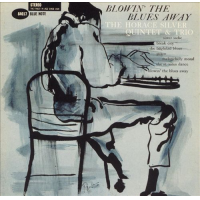 Pianist and composer Horace Silver continues to be an active member of the current jazz community and he can also lay claim to being the sole musician with the longest tenure on Blue Note, starting in the mid-'50s and staying on until almost the '80s. He led many fine bands over those years, but none more memorable that the quintet that featured trumpeter Blue Mitchell, saxophonist Junior Cook, bassist Gene Taylor, and drummer Louis Hayes (later to be replaced by Roy Brooks). Blowin' the Blues Away from 1959 is one of several distinguished Blue Note releases from that period, especially consequential for the introduction it gave us to "Sister Sadie." Aside from the ballad "Peace," there's nothing else here that would catch on big. However, Silver and company sound inspired and the program never fails to keep the listener satisfied.
Pianist and composer Horace Silver continues to be an active member of the current jazz community and he can also lay claim to being the sole musician with the longest tenure on Blue Note, starting in the mid-'50s and staying on until almost the '80s. He led many fine bands over those years, but none more memorable that the quintet that featured trumpeter Blue Mitchell, saxophonist Junior Cook, bassist Gene Taylor, and drummer Louis Hayes (later to be replaced by Roy Brooks). Blowin' the Blues Away from 1959 is one of several distinguished Blue Note releases from that period, especially consequential for the introduction it gave us to "Sister Sadie." Aside from the ballad "Peace," there's nothing else here that would catch on big. However, Silver and company sound inspired and the program never fails to keep the listener satisfied. 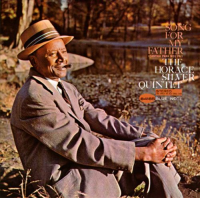 Easily one of his finest and most popular recorded moments, Silver's Song for My Father is also getting the Van Gelder treatment. Recorded in three dates over the span of a year, from October 1963 until the following April, this classic features two different quintets. The earlier group with Blue Mitchell, Junior Cook, Gene Taylor, and Roy Brooks had pretty much run its course and the new ensemble would feature trumpeter Carmell Jones, up-and-coming tenor star Joe Henderson, bassist Teddy Smith and Pittsburgh native and drummer supreme Roger Humphries.
Easily one of his finest and most popular recorded moments, Silver's Song for My Father is also getting the Van Gelder treatment. Recorded in three dates over the span of a year, from October 1963 until the following April, this classic features two different quintets. The earlier group with Blue Mitchell, Junior Cook, Gene Taylor, and Roy Brooks had pretty much run its course and the new ensemble would feature trumpeter Carmell Jones, up-and-coming tenor star Joe Henderson, bassist Teddy Smith and Pittsburgh native and drummer supreme Roger Humphries. Rare for Blue Notes of the time, the original vinyl version of this album was assembled piecemeal from the previously mentioned multiple sessions. Of course, you'll find the ubiquitous title track and Joe Henderson's "The Kicker." In addition, there are four performances added to the disc that appeared on various compilations in the past and on the previous CD version of this disc. Soundwise, this date has always had its flaws. There is audible distortion on the horns in several spots and Van Gelder has done all he can to improve the fidelity. Overall, the new master is a success, but beware that the glitches are still to be heard.
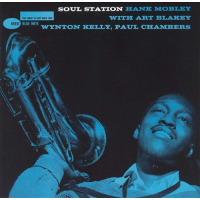 Like Silver, tenor saxophonist Hank Mobley was an artist closely associated with Blue Note. His catalog is marked by his '50s sessions and then subsequent dates that spanned a ten-year period from 1960 to 1970. The first issue of the latter series was to be one of Mobley's all-time classics. Soul Station is another record that comes close to musical perfection and rewards on many levels. First, there is Mobley's tenor saxophone work. His was a round (his own word) and melodious sound that had few predecessors and even fewer followers. His writing was marked by atypical phrase and bar lengths and creative, often modal harmonic structures. Lastly, the sideman here can't be beat. I mean, who can name a record featuring Wynton Kelly, Paul Chambers, and Art Blakey that didn't swing? Enough said.
Like Silver, tenor saxophonist Hank Mobley was an artist closely associated with Blue Note. His catalog is marked by his '50s sessions and then subsequent dates that spanned a ten-year period from 1960 to 1970. The first issue of the latter series was to be one of Mobley's all-time classics. Soul Station is another record that comes close to musical perfection and rewards on many levels. First, there is Mobley's tenor saxophone work. His was a round (his own word) and melodious sound that had few predecessors and even fewer followers. His writing was marked by atypical phrase and bar lengths and creative, often modal harmonic structures. Lastly, the sideman here can't be beat. I mean, who can name a record featuring Wynton Kelly, Paul Chambers, and Art Blakey that didn't swing? Enough said. 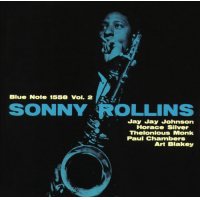 All of the preceding albums I've discussed were recorded at Van Gelder's studio in Englewood Cliffs, New Jersey, which he has occupied since July of 1959. The final three sets I'm about to discuss were cut at the engineer's previous recording site, his parent's living room in Hackensack. Although saxophonist Sonny Rollins had previously cut many a legendary session for Prestige (Saxophone Colossus comes to mind), During the course of one year, 1957, he would make a number of sides for Blue Note that remain a major part of his recorded legacy. Sonny Rollins Volume Two contains some good, if not great Rollins, but is probably better known for a rare sideman appearance from Thelonious Monk. Nothing all that revolutionary occurs here, but there's much to enjoy, the least of which is Van Gelder's new take on the mono master which cleans up the muddiness usually encountered on this set.
All of the preceding albums I've discussed were recorded at Van Gelder's studio in Englewood Cliffs, New Jersey, which he has occupied since July of 1959. The final three sets I'm about to discuss were cut at the engineer's previous recording site, his parent's living room in Hackensack. Although saxophonist Sonny Rollins had previously cut many a legendary session for Prestige (Saxophone Colossus comes to mind), During the course of one year, 1957, he would make a number of sides for Blue Note that remain a major part of his recorded legacy. Sonny Rollins Volume Two contains some good, if not great Rollins, but is probably better known for a rare sideman appearance from Thelonious Monk. Nothing all that revolutionary occurs here, but there's much to enjoy, the least of which is Van Gelder's new take on the mono master which cleans up the muddiness usually encountered on this set.  To redo Art Blakey's Moanin' was certainly an obvious choice. Its merits are well documented. Bobby Timmons' title track, along with Benny Golson's "Are You Real" and "Along Came Betty," more than likely became a standard minutes after it was first issued . So what could make this one any better? Well again, the sound quality is noticeably improved. Plus, we get a previously unissued take of the title track and 35 seconds of studio banter between Lee Morgan and Van Gelder that comes close to some "you are there" goosebumps! Once again, trade in the oldies and grab this new version.
To redo Art Blakey's Moanin' was certainly an obvious choice. Its merits are well documented. Bobby Timmons' title track, along with Benny Golson's "Are You Real" and "Along Came Betty," more than likely became a standard minutes after it was first issued . So what could make this one any better? Well again, the sound quality is noticeably improved. Plus, we get a previously unissued take of the title track and 35 seconds of studio banter between Lee Morgan and Van Gelder that comes close to some "you are there" goosebumps! Once again, trade in the oldies and grab this new version. 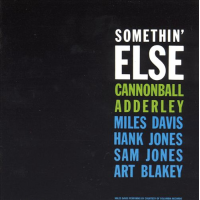 Finally, we come to Cannonball Adderley's Somethin' Else, a great contender for one of those lists compiling the top 100 most important jazz recordings. You know the story-Miles Davis, Hank Jones, Sam Jones, and Art Blakey. Much has been made of Davis' contributions to this one, yet Adderley is no slouch as evidenced by a wonderful romp through "Dancing in the Dark." A previously issued bonus cut that had been identified as "Allison's Uncle" is now being claimed as Hank Jones' "Rangoon." As for the sound quality, a comparison made with a now out-of-print Mobile Fidelity gold disc found neither version winning. Each had its merits and depending on your tastes there was little else to choose between the two.
Finally, we come to Cannonball Adderley's Somethin' Else, a great contender for one of those lists compiling the top 100 most important jazz recordings. You know the story-Miles Davis, Hank Jones, Sam Jones, and Art Blakey. Much has been made of Davis' contributions to this one, yet Adderley is no slouch as evidenced by a wonderful romp through "Dancing in the Dark." A previously issued bonus cut that had been identified as "Allison's Uncle" is now being claimed as Hank Jones' "Rangoon." As for the sound quality, a comparison made with a now out-of-print Mobile Fidelity gold disc found neither version winning. Each had its merits and depending on your tastes there was little else to choose between the two. Thanks to Blue Note for what has turned out to be a novel and very rewarding concept. That's probably enough to digest in one reading and a few sittings. However, look for the reviews of further RVG Editions next month.
< Previous
Interview with Tom Varner
Next >
Mnemosyne
Comments
Tags
McCoy Tyner
Multiple Reviews
C. Andrew Hovan
United States
John Coltrane
Hank Mobley
Wayne Shorter
lee morgan
Joe Henderson
Ron Carter
Elvin Jones
Kenny Burrell
Stanley Turrentine
Major Holley
Ray Barretto
Dexter Gordon
Sonny Clark
Billy Higgins
Eric Dolphy
Freddie Hubbard
Bobby Hutcherson
Richard Davis
Tony Williams
Miles Davis
Horace Silver
Blue Mitchell
Junior Cook
Gene Taylor
Louis Hayes
Carmell Jones
Wynton Kelly
Paul Chambers
Art Blakey
Sonny Rollins
Bobby Timmons
benny golson
Cannonball Adderley
Hank Jones
Sam Jones
For the Love of Jazz
 All About Jazz has been a pillar of jazz since 1995, championing it as an art form and, more importantly, supporting the musicians who create it. Our enduring commitment has made "AAJ" one of the most culturally important websites of its kind, read by hundreds of thousands of fans, musicians and industry figures every month.
All About Jazz has been a pillar of jazz since 1995, championing it as an art form and, more importantly, supporting the musicians who create it. Our enduring commitment has made "AAJ" one of the most culturally important websites of its kind, read by hundreds of thousands of fans, musicians and industry figures every month.



















